[Home][Table
of Contents][What's
New][Picture
Gallery][USMC Picture Pages
]
[FMFCorpsmen][Combat
Wives][Combat
Histories][Memorials]
[Poems, Memoirs][Links][Guestbook]
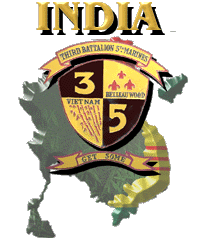
"Operation
ALAMO"
Battle
For The Unnamed Island
"Operation ALAMO" also called "NO NAME 98"
On the 30th of January, 1968, the 3/5 Alpha Command Group and India Co. were heli-lifted into a suspected enemy position in the Northernmost portion of the TAOR vicinity BT04715. With ARVN blocking, India Co. conducted a well-coordinated sweep of the area, which contained an estimated enemy battalion. Upon completion of the sweep, there was a confirmed count of 102 VC KIA, 88 POWs, 13 VC suspects and 70 laborers. Captured enemy equipment, weapons, medical supplies, documents, etc. are included in January's total captured equipment (See paragraph 7). The enemy force was a combination of hard-core VC from several different units. Members of the R-20th Bn, the V-25th Bn, and the C130 Bn were included. Intentions of the unit prior to the contact are unknown except for the probable mission of harrassment of the Da Nang area. During TET 3/5 suffered light casualties in comparison to the casualties inflicted upon the enemy. (3rd Bn, 5th Marines AAR, pg. 7)
3rd
Battalion, 5th Marines Combat After Action Report
January 1968
(Operation ALAMO is referred to on page 7 and 11.
Reports and notes from John Gundersen)
Pages 1-8
Pages 9-15
Article
in the Sea Tiger about "Operation ALAMO" written by USMC correspondent,
Earl Gerheim.
Also, handwritten document about the weapons recovered by the Marines
of India Co. 3/5.
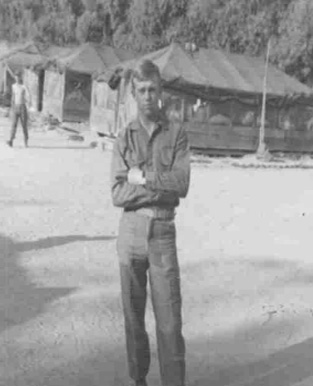
John
Gundersen
(picture courtesy of John Gundersen)
Submitted
by John Gundersen
"Welcome to TET"
On the morning of January 30, 1968, India Company was choppered to a large open rice paddy just south of the DaNang airstrip. Small arms and automatic weapons were firing on us as we landed. We ran to the east side of the rice paddy, taking cover behind a berm that held a tributary of the Vien Dien River in its course, and returned fire. After about five minutes, the enemy stopped firing.
We got up and conducted a sweep westward to Highway 1. Pausing a few minutes, we turned and swept the same direction we had come from. We had just cleared a treeline and were about 100 meters into the paddy which had served as our LZ. Suddenly, small arms and automatic weapons fire filled the air. Mortars began falling on our positions. We returned fire on a well-entrenched enemy fighting for an hour or so. We had 7 KIA.
F-4 Phantoms began a spotting run, and we ceased firing to allow them to complete their sortie. The aircraft began their strafing run dropping both high explosives and napalm. Our position was only about 150 meters from the enemy’s treeline. I remember the concussion from each bomb shaking my face and eyeballs. The explosions blurred my vision momentarily. Small pieces of shrapnel were falling on us, with some larger pieces buzzing over our heads. I was amazed at the power of the bombs. I couldn’t imagine anyone escaping such a pounding.
After the sortie had finished, we moved about 50 meters crossing a small footbridge. It spanned a small canal which emptied into the tributary. We then began moving towards Lo Giang, (pronounced Low Yong), an enemy-held village. The enemy opened fire on us again. This engagement lasted another hour or so. I couldn’t believe the volume of fire that was coming at us. There seemed to be no reduction in enemy strength after the bombing run.
L/Cpl Petersen approached Captain Kolakowski (India Co. Commander) and volunteered to walk point into the village. We followed the path leading from the footbridge to a walkthrough gate at the entrance of the village. As Petersen was about 20 meters from the gate, a lone sniper shot him in the chest killing him instantly. His squad stopped to tend to him while my squad was sent into the village. At this time, my squad was on point. We were ordered to enter through the gate, turn west along the treeline about 100 meters, and hold up.
As we ran, I remember seeing numerous one and two man fighting holes on the edge of the treeline. After stopping, I was surprised to see that only my fireteam was there. We did a quick ammo check, discovering we were very low on rounds, having only two grenades and two magazines of ammo between us. Luckily, we met no resistance before being ordered back to the rest of the platoon to dig in.
We set up our perimeter in the southeast corner of the village. From the small gate, a path curved around to the right ending at the tributary river. It was on this pathway that we were ordered to dig in. The path was bout 8 feet lower in elevation than the rest of the village, isolating our position. The banks of the path sloped gradually up to the village on both sides. It was incredible that we were setting up in the vulnerable position. We sat in these holes until dusk. At that time, we were re-supplied, and told to move to the top of the slope and dig in again.
It was very quiet until sometime well after dark. I remember sitting there in the pitch black night thinking how hard it would be to see anyone sneaking up on us. Suddenly someone inside our perimeter whistled. I was about to tell them to be quiet, when a wall of tracers ripped through my position from the north. This lasted about two minutes, when a different whistle sounded (These whistles resembled various bird calls). With that, they hit the perimeter from the west side. With a third whistle, they hit the northwest side.
A flareship began dropping illumination canisters. We could see the enemy massing in front of us, so we called in the artillery. To escape the shelling which was right on target, they rushed toward us. Behind us, the Command Post began adjusting fire, by dropping the target a few meters at a time, forcing the enemy into our perimeter. They rushed in randomly, sometimes alone, sometimes in small groups. Most were killed as they advanced toward us, falling onto the pathway. Some, however, broke through our line becoming trapped between us and the second platoon before being killed. This went on for quite a while before someone found the whistler and killed him. It was obvious that he had infiltrated our perimeter and was coordinating the enemy attack. From that point on, they concentrated their attack on our machine gun emplacement that was near the small gate.
I remember an illumination burst, and I saw a man in black pajamas running along the path from the river towards the gate. He had several grenades cradled in one arm, and he was throwing them into our abandoned fighting holes as he ran. I shot him. As he fell, the grenades he was carrying exploded blowing him up. He apparently had pulled all the pins before attacking.
The artillery kept pounding closer and closer while the enemy’s 122 mm rockets began screaming overhead like freight trains. We could hear them hitting the airstrip. The sounds of the arty, the rockets, the motors and the grenades combined with the eerie swaying of the illumination on their parachutes created a hellish vision. Never before, or since, have I been in such an acute state of fear.
The battle was, for the most part, over by dawn. The bodies of the enemy soldiers were strewn about not more than 15 meters in front of our perimeter swelling in depth, in front of the machine gun, to as much as six deep. I was awed by the sight of all those bodies. It seemed that the enemy never realized that we had moved from the fighting holes in the path spending the whole night and their lives attacking those holes. It seemed amazing we had no KIA’s that night.
We moved out that morning and swept the area between us and the river to the north toward the airstrip. We then turned around and swept back into the rice paddy passing through the village (both were the same ones from the day before). We then lined up on the bank of the river to the east. The amtracks were there on the other side of the river. I remember watching one that had about 15 prisoners on top of it tied up and blindfolded. All of a sudden a VC sprung out of a spider hole and threw a chi comm grenade at the Amtrack. I couldn’t fathom anyone who would give up his life in an attempt to blow up an amtrack vehicle with a chi comm. One of the amtrack crew walked around from the other side of the vehicle and shot him.
Even though this operation had no official name, the men of India Co. 3/5 referred to it as Operation ALAMO.
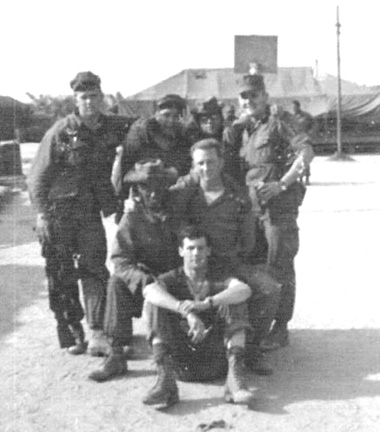
Front
is Roger (Doc) Olson, KIA 3/26/00; Kneeling from left: August (Gus) Howard,
Michael Hulsey
Standing from left: Gunny Gunderson, Boyd (Chief) Chegup (Ute Indian),
Eddie Garcia, Charles (Chunky) Stonebreaker
(picture couartesy of John Gundersen)
*********************************************
Submitted by Eddie Garcia, India 3/5
The ALAMO was one of my first real fight that I would come across. I was not sure how I was going to react, but up to that point I was doing pretty good. When we first got dropped off, everything was pretty quiet and eerie like everything was like slow motion. We started to walk across the paddy, and then all hell broke loose. The first people to get hit were all in front lines, but we kept moving. I remember the first person to get hit in front of me, got hit in the big finger on his right hand. The reason I remember is that he was going down from a paddy dike and I was coming up. If his hand had not been there, I would not be writing this.
Then they told us to hold our position because they had called in air support, boy when the F14 came in just the noise shocked me, and when they dropped them bombs I felt like hiding up my rear. Then after everything was quiet, we went and grabbed the dead and wounded. I remember I helped this one kid on the poncho... good-looking, All American, blond hair and blue eyes. He had but a little wound on his neck, and looked like he was only sleeping. I still see him once in awhile, may he rest in peace. Then it was back to cleaning up what was ahead of us the village.
As we regrouped to enter the ville, I remember L/Cpl. Peterson went to the front and said something to Sgt. Pruitt. After that he got up and started to walk into the ville. As he was approaching the gate to go in, there was one shot and he fell. As everything went crazy, Gunny, Parks, Morgan and me went into the village. Let me tell you that was one hell on experience to go through after all that fighting and seeing our boys dead and wounded and not seeing any enemy. It's pretty eerie.
Then we went through the ville, I heard a noise coming from my left and I fired. I got one (a pretty big pig with his guts coming all out). I guess that broke the tightness we had, after that we started to get broken down into fighting holes. I was to the right of the river near a road, there four of us and between all of us we had enough rounds and grenades to fight two water buffalos. As the night went on there was whistling from inside our perimeter then one shot and silence for what seemed like two minutes, and then my God all hell broke loose. There was all kinds of tracers with different colors and then what seemed to last the whole night, silence came upon us.
In the morning when we went to check in front of us were nothing but bodies all over the place. I had not seen so many bodies since Custer got killed. Then we went and cleared the village and walked to the river where we took some more prisoners. There's more, but I think this enough.
*********************************

Killed
In Action on Operation ALAMO
Their names stand proudly on the India
3/5 Wall of Honor
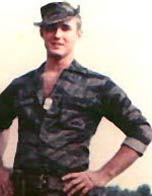
CPL.
BILLY CARROLL BOLTON
Born
on Sept. 20, 1946
From VICTORIA, TEXAS
Casualty was on Jan 30, 1968
in QUANG NAM, SOUTH VIETNAM
Panel 35E - - Line 66
Memorial
page
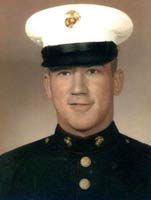
LCPL.
ROBERT VERNON PETERSON
Born on Oct. 6, 1947
From CANTON, MISSISSIPPI
Casualty was on Jan. 30, 1968
in QUANG NAM, SOUTH VIETNAM
Panel 35E - - Line 77
Memorial page

LCPL.
NORMAN CASEY BALLARD
Born on Dec. 24, 1948
From FELDA, FLORIDA
Casualty was on Jan. 30, 1968
in QUANG NAM, SOUTH VIETNAM
HOSTILE, GROUND CASUALTY
GUN, SMALL ARMS FIRE
Panel 35E - - Line 65
Memorial page
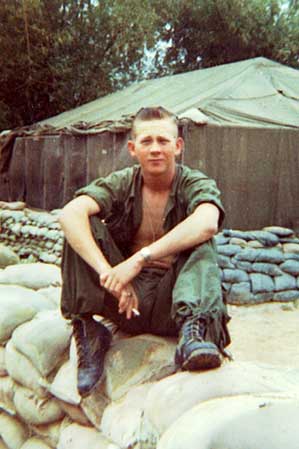
Roy Jackson
PFC.
ROY LEE JACKSON
Born on June 18, 1949
From CANDOR, NORTH CAROLINA
Casualty was on Jan. 30, 1968
in QUANG NAM, SOUTH VIETNAM
Panel 35E - - Line 73
Memorial page

LCPL.
THOMAS JACOB TORRINGTON
Born on July 8, 1948
From CUMBERLAND, MARYLAND
Casualty was on Jan. 31, 1968
in QUANG NAM, SOUTH VIETNAM
Panel 36E - - Line 40
Memorial page
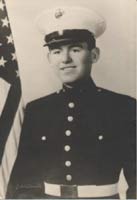
CPL.
GERALD MICHAEL MARKOSKI
Born on Jan.
6, 1948
From WEST CONSHOHOCKEN, PENNSYLVANIA
Casualty was on Jan. 31, 1968
in QUANG NAM, SOUTH VIETNAM
Panel 36E - - Line 37
Memorial page
LCPL.
O'NEAL WRIGHT
Born on Feb. 25, 1948
From NEW ROCHELLE, NEW YORK
Casualty was on Jan. 31, 1968
in QUANG NAM, SOUTH VIETNAM
Panel 36E - - Line 44
Memorial page

[Home][Table
of Contents][What's
New][Picture
Gallery][USMC Picture Pages
]
[FMFCorpsmen][Combat
Wives][Combat
Histories][Memorials]
[Poems, Memoirs][Links][Guestbook]


















